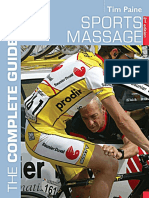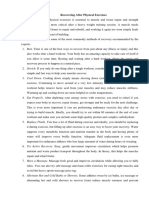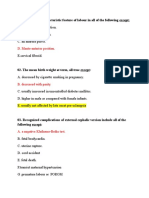Massage: The Application of Massage in Sport
Massage: The Application of Massage in Sport
Uploaded by
VladGrosuCopyright:
Available Formats
Massage: The Application of Massage in Sport
Massage: The Application of Massage in Sport
Uploaded by
VladGrosuOriginal Title
Copyright
Available Formats
Share this document
Did you find this document useful?
Is this content inappropriate?
Copyright:
Available Formats
Massage: The Application of Massage in Sport
Massage: The Application of Massage in Sport
Uploaded by
VladGrosuCopyright:
Available Formats
Massage
Massage can be defined as the methodic manipulation of the soft body tissues through
manual or mechanical actions with physiological, psychological, prophylactic and therapeutic
purposes. Massage has effects on the blood circulation, subcutaneous circulation, the arterial
system, the musculoskeletal system, the muscular contraction and the relaxation. It can be
applied with hands, fingers, elbows, knees, forearms, feet and other medical aids. In professional
settings massage involves the client being treated while lying on a massage table, sitting in
a massage chair, or lying on a mat on the floor. The massage subject may be fully or
partly unclothed. Parts of the body may be covered with towels or sheets. The most cited reasons
for introducing massage as therapy have been client demand and perceived clinical effectiveness.
Massage therapy is one of the oldest health care practices known to history. References to
massage are found in Chinese medical texts more than 4000 years old and in many writings from
ancient civilizations including Rome, Greece, India, Japan China, Egypt and Mesopotamia. In
modern times massage is popular all over the world and is still gaining in popularity. Medical
researches have shown that the benefits of massage include pain relief in the areas of spinal cord,
shoulder, and back, helps patients with diskal hernia, fault in posture, reduced
trait anxiety and depression, temporarily reduced blood pressure and heart rate. Massage is not
recommended in cases of deep vein thrombosis, bleeding disorders, damaged blood vessels,
hypertension, weakened bones from cancer, osteoporosis, or fractures, and fever. Practitioners of
massage include massage therapists (masseur or masseuse), athletic trainers (the 1996 Summer
Olympics in Atlanta was the first time that massage was offered as a core medical service) and
physical therapists.
The application of massage in sport
According to some research, applying the massage in the medical recovery and
rehabilitation is an important means of shortening the inactivity time of the sportsmen. This
determines the planning and achievement of a bigger training volume, which means 2 or 3
training sessions a day. The massage is one of the most important “relaxations without
inhibition, activation and functional stimulation without effort method”.
It can be applied in the following situations:
- In the training period (usually after the training session);
- In the competition period; before the contest; between contests; after contests;
- In the medical rehabilitation period;
- In case of specific accidents and injuries, as follows: a) in lesions of the peripheral soft
tissues; b) in muscle and tendons lesions; c) in joint injuries; d) in bone injuries; e) in peripheral
nerves injuries; e) in case of functional disorders; f) in over-training; g) in physical exhaustion.
You might also like
- 10 Social em - 2023 2024Document82 pages10 Social em - 2023 2024b491002450% (2)
- The Complete Guide To Sports MassageDocument425 pagesThe Complete Guide To Sports MassageMhelvyn Neil Francisco80% (5)
- Mastering IELTS Writing Task 2 PDF EbookDocument208 pagesMastering IELTS Writing Task 2 PDF EbookOmar Clark97% (38)
- Clinical Chemistry McqsDocument26 pagesClinical Chemistry McqsAhmed Aboamer100% (10)
- Chapter04 PDFDocument40 pagesChapter04 PDFPaul Mwangi Makau100% (1)
- 4 History of MassageDocument3 pages4 History of MassageJoanna AaronNo ratings yet
- Massage TherapyDocument7 pagesMassage TherapyDan ZkyNo ratings yet
- Rahonauth & Bilar & RamlessurDocument25 pagesRahonauth & Bilar & RamlessuryazNo ratings yet
- Manipulative and Body Based PracticeDocument9 pagesManipulative and Body Based PracticeObremponba Kwadwo MensahNo ratings yet
- Massage TherapyDocument132 pagesMassage TherapyCristina UrsuNo ratings yet
- Sport Massage New Manual 2017 PDFDocument115 pagesSport Massage New Manual 2017 PDFFritz Oiro100% (4)
- The History of Massage in Modern TimesDocument7 pagesThe History of Massage in Modern TimessalambishalsinghNo ratings yet
- Virtues of Massage and Spa Treatments: BenefitsDocument1 pageVirtues of Massage and Spa Treatments: BenefitsMary Ann FrancisNo ratings yet
- Massage Therapy: A Comprehensive Guide with Secret Tips and Benefits of Massage TherapyFrom EverandMassage Therapy: A Comprehensive Guide with Secret Tips and Benefits of Massage TherapyRating: 5 out of 5 stars5/5 (2)
- Trend and Issue in Complementary CareDocument7 pagesTrend and Issue in Complementary CarekmmayNo ratings yet
- Complete Download Integrated Sports Massage Therapy A Comprehensive Handbook 1e 1st Edition Anders Jelvéus Dn Leg. Naprapat Mtom Lac Cmt PDF All ChaptersDocument45 pagesComplete Download Integrated Sports Massage Therapy A Comprehensive Handbook 1e 1st Edition Anders Jelvéus Dn Leg. Naprapat Mtom Lac Cmt PDF All Chapterspkykalbim100% (1)
- PHT 441 Lecture 1 2024Document19 pagesPHT 441 Lecture 1 2024MARYANN NDUNo ratings yet
- Manual Therapy Lecture 1Document30 pagesManual Therapy Lecture 1abrarhsyn2020No ratings yet
- Effects of Massage On Patients With Cancer Margaret Omulindi Research PaperDocument16 pagesEffects of Massage On Patients With Cancer Margaret Omulindi Research Paperapi-314245593No ratings yet
- 8286Document81 pages8286daripfoyezNo ratings yet
- N100 Rle Back MassageDocument24 pagesN100 Rle Back MassagerlinaoNo ratings yet
- Indications and Contraindications: Massage Denotes A MoreDocument6 pagesIndications and Contraindications: Massage Denotes A MoreMiljan MadicNo ratings yet
- Referat Limba Engleză-Zidaroiu Ionuț-EduardDocument6 pagesReferat Limba Engleză-Zidaroiu Ionuț-EduardEduard IonutNo ratings yet
- Introduction To Massage TherapyDocument2 pagesIntroduction To Massage TherapysalimhillNo ratings yet
- Massage Therapy: An Introduction: Key PointsDocument6 pagesMassage Therapy: An Introduction: Key PointszubaricaNo ratings yet
- Massage TherapyDocument26 pagesMassage TherapyChum del Rosario100% (1)
- Integrated Sports Massage Therapy A Comprehensive Handbook 1e 1st Edition Anders Jelvéus DN Leg. Naprapat Mtom Lac CMTDocument84 pagesIntegrated Sports Massage Therapy A Comprehensive Handbook 1e 1st Edition Anders Jelvéus DN Leg. Naprapat Mtom Lac CMTdhoestmuzere29100% (3)
- Massage FactsDocument3 pagesMassage Factstnelson65No ratings yet
- Massage Career GuideDocument24 pagesMassage Career GuideDyang SpaNo ratings yet
- Benefits of Massage PowerpointDocument31 pagesBenefits of Massage PowerpointJeremiah TannNo ratings yet
- Massage Bahasa InggrisDocument8 pagesMassage Bahasa InggrisAmyNo ratings yet
- Massage CourseDocument14 pagesMassage CourseScribdTranslationsNo ratings yet
- TP Anglais L3SP Phy - 065726Document7 pagesTP Anglais L3SP Phy - 065726Donatien dnNo ratings yet
- Massage TherapyDocument46 pagesMassage TherapyikharratNo ratings yet
- Sports MassageDocument11 pagesSports MassageHari SetiawanNo ratings yet
- Neck Hurt After MassageDocument3 pagesNeck Hurt After Massagemirzauzairbaig84No ratings yet
- Effleurage Is A Light Friction Technique Commonly Used To Begin A Massage TreatmentDocument3 pagesEffleurage Is A Light Friction Technique Commonly Used To Begin A Massage TreatmentMikki lor PuaganNo ratings yet
- Bahasa Inggris Massage BesokDocument17 pagesBahasa Inggris Massage Besokagus suadnyanaNo ratings yet
- 507 Beauty and SpaDocument38 pages507 Beauty and SpaJandro Kareem100% (1)
- Massage: The Best Massage Techniques From Around The WorldFrom EverandMassage: The Best Massage Techniques From Around The WorldRating: 5 out of 5 stars5/5 (2)
- Chiropractic Massage BenefitsDocument5 pagesChiropractic Massage BenefitsBaldogNo ratings yet
- Sport MassageDocument8 pagesSport MassageRajesh MenonNo ratings yet
- Typesofmassages 130630182057 Phpapp02Document12 pagesTypesofmassages 130630182057 Phpapp02Ana DazaNo ratings yet
- N100 Rle Back MassageDocument24 pagesN100 Rle Back Massageoxidalaj100% (1)
- Sports Massage BookDocument69 pagesSports Massage BookScribdTranslationsNo ratings yet
- Remedial MassageDocument4 pagesRemedial MassageKellenNo ratings yet
- Unit 1. PhysiotherapyDocument9 pagesUnit 1. PhysiotherapyAna CáceresNo ratings yet
- Definition of MassageDocument13 pagesDefinition of MassageJohn Kenneth IsananNo ratings yet
- archivev3i3MDIwMTMxMTI0 PDFDocument7 pagesarchivev3i3MDIwMTMxMTI0 PDFLatasha WilderNo ratings yet
- Masaj de RelaxareDocument1 pageMasaj de RelaxareTanase AntonelNo ratings yet
- Emilio Pucci - Senior Project - Complete Perfect Beautiful Final Draft of EssayDocument12 pagesEmilio Pucci - Senior Project - Complete Perfect Beautiful Final Draft of Essayapi-660354793No ratings yet
- Laser Light Therapy: Compression Therapy Chest Physiotherapy Cardiovascular ConditioningDocument4 pagesLaser Light Therapy: Compression Therapy Chest Physiotherapy Cardiovascular ConditioningPreethiHonavarNo ratings yet
- Deep Tissue MassageDocument6 pagesDeep Tissue MassageGheorghita DanielNo ratings yet
- Sports MassageDocument18 pagesSports MassageKanak Soni100% (2)
- Basics of PhysiotherapyDocument86 pagesBasics of PhysiotherapyNestor BalboaNo ratings yet
- Massage BenefitsDocument2 pagesMassage BenefitsCleyton MendesNo ratings yet
- Physical TherapyDocument2 pagesPhysical TherapyMISBACHUSSURURNo ratings yet
- Alternative and Complemntry TheoryDocument18 pagesAlternative and Complemntry TheoryDeepika PatidarNo ratings yet
- What Is Physiotherapy? When and The Form of Physiotherapy?Document3 pagesWhat Is Physiotherapy? When and The Form of Physiotherapy?Dimas SamidNo ratings yet
- Therapeutic MassageDocument46 pagesTherapeutic MassageBonbon Kim100% (4)
- Name . Group . Date .Document3 pagesName . Group . Date .VladGrosuNo ratings yet
- Rehabilitation Guidelines For Patients Undergoing Surgery For Lateral Ligament Reconstruction of The AnkleDocument10 pagesRehabilitation Guidelines For Patients Undergoing Surgery For Lateral Ligament Reconstruction of The AnkleVladGrosuNo ratings yet
- Injury and Overuse Injury.: Classification of Sports InjuriesDocument2 pagesInjury and Overuse Injury.: Classification of Sports InjuriesVladGrosuNo ratings yet
- Famous PhysiciansDocument2 pagesFamous PhysiciansVladGrosuNo ratings yet
- 4 Winter-SportsDocument1 page4 Winter-SportsVladGrosuNo ratings yet
- Recovering After Physical ExercisesDocument2 pagesRecovering After Physical ExercisesVladGrosuNo ratings yet
- Hygiene Is A Component of Education Which, in The Sportive and in Any Person WhoDocument2 pagesHygiene Is A Component of Education Which, in The Sportive and in Any Person WhoVladGrosuNo ratings yet
- Prevention of Sports InjuriesDocument1 pagePrevention of Sports InjuriesVladGrosuNo ratings yet
- Sports Medicine Specializes in Preventing, Diagnosing and Treating InjuriesDocument2 pagesSports Medicine Specializes in Preventing, Diagnosing and Treating InjuriesVladGrosuNo ratings yet
- Sports Nutrition: "Eat To Live, Not Live To Eat" ProverbDocument1 pageSports Nutrition: "Eat To Live, Not Live To Eat" ProverbVladGrosuNo ratings yet
- Techniques of MassageDocument1 pageTechniques of MassageVladGrosuNo ratings yet
- Remedial GymnasticsDocument1 pageRemedial GymnasticsVladGrosuNo ratings yet
- REferat Engleza Sport NutritionDocument11 pagesREferat Engleza Sport NutritionVladGrosuNo ratings yet
- AN ANALYSIS OF ALFRED DESENCLOS QuatuorDocument79 pagesAN ANALYSIS OF ALFRED DESENCLOS QuatuorTaroNo ratings yet
- Prof. Chu-Young Kim - CVDocument4 pagesProf. Chu-Young Kim - CVKhairil AnshariNo ratings yet
- The First Philippine RepublicDocument21 pagesThe First Philippine RepublicMa Luisa InsonNo ratings yet
- Financial AccountingDocument104 pagesFinancial AccountingRuban ThomasNo ratings yet
- Creative WritingDocument2 pagesCreative WritingCathrina EngresoNo ratings yet
- Final Degree Thesis 2Document59 pagesFinal Degree Thesis 2jzwwdzvq48No ratings yet
- FCE CvičeníDocument8 pagesFCE CvičeníLucinkaNo ratings yet
- Idiom & Collocation WorkDocument2 pagesIdiom & Collocation Workmjomarkes208No ratings yet
- Kelly Steffen - Resume - 2018Document2 pagesKelly Steffen - Resume - 2018api-419130508No ratings yet
- Law of Tort 1Document3 pagesLaw of Tort 1ValerieNo ratings yet
- Sample No. Long Short Phi R: A B C DDocument22 pagesSample No. Long Short Phi R: A B C DRMNo ratings yet
- To Study Effect of Drought On Coriander (Coriandrum Sativum) For Morpho-Physiological TraitsDocument67 pagesTo Study Effect of Drought On Coriander (Coriandrum Sativum) For Morpho-Physiological TraitsrahulNo ratings yet
- Schoolarship Exam MCQsDocument12 pagesSchoolarship Exam MCQsSaber AlasmarNo ratings yet
- Women in Gaming 100 Professionals of Play by Meagan Marie Small DownloadDocument177 pagesWomen in Gaming 100 Professionals of Play by Meagan Marie Small DownloadKibaldNo ratings yet
- Conf IntDocument1 pageConf IntAnastasia SusciucNo ratings yet
- SOAL PAS B.ING KLS 7 Sem 1Document5 pagesSOAL PAS B.ING KLS 7 Sem 1said kosimNo ratings yet
- Xi-Narration SpeechDocument9 pagesXi-Narration SpeechAr Abu Tarek KhokaNo ratings yet
- Mandrakes: A Mystical Plant or Legitimate Herbal Remedy? The Chamber of Secrets Has Been Open!Document4 pagesMandrakes: A Mystical Plant or Legitimate Herbal Remedy? The Chamber of Secrets Has Been Open!outdash2No ratings yet
- Midnight Sun: From Wikipedia, The Free EncyclopediaDocument4 pagesMidnight Sun: From Wikipedia, The Free EncyclopediaKooroshNo ratings yet
- Torrens System - Re-Registration of Spanish TitlesDocument8 pagesTorrens System - Re-Registration of Spanish Titleshandsam84100% (2)
- Learn To Pronounce: AdjectiveDocument6 pagesLearn To Pronounce: AdjectiveLuisNo ratings yet
- Interpretation "A Bout A Boy"Document7 pagesInterpretation "A Bout A Boy"walNo ratings yet
- Ice Cream Shop ProjectDocument5 pagesIce Cream Shop Projectapi-482939526No ratings yet
- Mulatu DagnachewDocument84 pagesMulatu DagnachewmenbereNo ratings yet
- Assignment 3Document9 pagesAssignment 3Nikhil GoyalNo ratings yet
- Baldur-S Gate - Dark Alliance - Interplay ProductionsDocument21 pagesBaldur-S Gate - Dark Alliance - Interplay ProductionsadvgSNo ratings yet
- Alignment (Role-Playing Games)Document6 pagesAlignment (Role-Playing Games)G. Mac AoidhNo ratings yet






































































































